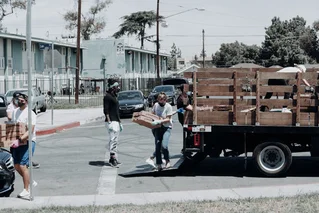
The Importance of Supporting Long-term Disaster Recovery
It is common for donors to reactively donate to a cause right after tragedy strikes. While those impacted do need help immediately, they will also need continuing help.
From 2011 to 2020, 19 hurricanes made landfall in the United States. In the years from 2013-2022, the U.S. experienced an average of 15,723 fires per year, burning 708,513 acres. The U.S. averages one chemical fire, explosion, or toxic release every two days. Most of us would probably be hard-pressed to remember the name of or the events surrounding more than a handful of the disasters that have occurred in the last decade. And yet, the impacts of those widely-forgotten disasters are still very much present in the communities where they took place.
What Are Disasters?
According to the Center for Disaster Philanthropy (CDP),
A disaster is a serious disruption of the functioning of a community or a society at any scale due to hazardous events interacting with conditions of exposure, vulnerability and capacity, leading to one or more of the following: human, material, economic and environmental losses and impacts. Damage and loss may be immediate, but the impact will last for a long time and usually requires years of recovery.
The CDP defines toxic spills, explosions, earthquakes, volcanoes, storms, floods, droughts, wildfires, epidemics, tsunamis, landslides, and more as disasters. Each time one of these disasters strikes, or slowly develops, it creates years of work toward recovery. For some communities, the next disaster will strike before recovery from the previous disaster has been completed.
Why Donors Should Fund Long-term Disaster Recovery
For donors, the impulse to support disaster recovery is often triggered during or immediately after a disaster, when images of the damage flood the news. This inclination to give in the moment, inspired by compassion and empathy, is a good one. The impacted communities need help immediately. But they also need help in the long term. With an endless stream of disasters, accelerated by climate change, to keep the attention of the public, very few donors are sticking around to support the long, hard work of recovery. Research from CDP reveals that while 31% of U.S. households made a donation to disaster recovery in 2017, in 2018 only 5% of households donated to disasters that occurred in 2017. An additional 3% of households donated for disasters that occurred prior to 2017.
As a donor, you have the opportunity to make a real impact for disaster-stricken communities by showing up for them not just in the throes of or immediate aftermath of a disaster, but for the years it takes them to recover, rebuild, and prepare for the next disaster.
Areas of Focus for Long-term Recovery
While each disaster creates a slightly different set of needs, there are common themes that can help to guide your giving in the years after a disaster.
Marginalized Populations: Structural inequalities are exacerbated by disasters. Marginalized communities are most likely to suffer the worst of disasters and have the fewest resources to recover. Indigenous peoples, people of color, and people experiencing poverty are all more likely to suffer the greatest consequences of disasters. Other groups to consider include older adults and people with disabilities. These communities can benefit most from donations after a disaster, as their needs are the greatest. Often, these communities are also excluded from support. Donors can center these communities to maximize their impact.
Structural Rebuilding: Many disasters are exacerbated by insufficient or poorly placed infrastructure, which can take the form of houses built in flood zones (vulnerable to hurricanes), a lack of sufficient water storage (a factor in how badly a drought impacts an area), insufficiently resilient buildings (at risk from earthquakes), and much more. Structures that are destroyed or otherwise prove to be unable to survive, or help the community survive, a disaster must be expanded, rebuilt, retrofitted, or moved. However, building back to the same pre-disaster level is not a good option as it leaves the community open to the same level of damage, or greater damage from a future disaster. Building back better is time-consuming, and cost-intensive in the short-term, but over time it is cost-effective. Impact-focused donors can focus on improving infrastructure in impacted communities after disasters to make a lasting difference.
Mental Health: One of the often-overlooked aspects of disasters is the long-term impacts on residents’ mental health. Loss of life, homes, and normalcy take their toll on human mental health. These impacts are magnified for people who experience multiple disasters. The consequences of the loss may not manifest immediately, and they can last a lifetime. Donors who want to help communities recover in the long term may choose to focus on mental health. Learn more.
To learn about the specific long-term needs created by a particular disaster, CDP provides profiles of disasters past and ongoing that provide key insights for donors. Local government and NGOs like community foundations are also well-equipped with knowledge of needs and resources on the ground. These resources can help you guide your giving to meet local long-term needs effectively.
Next time a disaster strikes and you are moved to make a donation, consider making that disaster part of your long-term giving strategy. You can find and vet charities in the impacted areas through Charity Navigator’s search to make your donations with confidence. And remember, it is not too late to support ongoing recovery from previous disasters.





